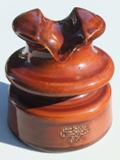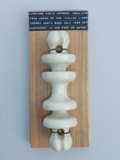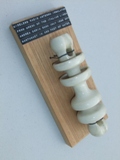| Image |
Manufacturer |
Model |
Markings |
Color |
Year |
History |
Condition* |
Use |
Style# |
U/M# |
Type |
Dimensions |
Weight |
Cleaned |
 |
Oliver |
2000 |
OLIVER 2000 (top) U U.S.A. (bottom) recess embossed |
brown |
1944-1960 |
Oliver Electrical Mfg. Co. (1956-1959) Battle Creek, MI (founded by Henry W. Oliver, James Oliver, or Joseph Doty Oliver) or Oliver Corp. (1944-1960) |
minor damage (1 small nick) |
power distribution |
2000 |
n/a |
secondary rack/dead end spool, single groove |
3.05"W x 2.97"H meas'd (3" x 3") |
17.00 oz. |
No |
 |
N |
knob |
N (top) embossed |
white |
1911-1927 |
National Electric Porcelain Co. (1911-1927) Carey, OH (W.L. Bish, President) |
no damage |
power distribution |
knob |
n/a |
nail/screw solid knob, single groove |
1.55"W x 1.96"H meas'd (1.5" x 1.875") |
3.55 oz. |
No |
 |
Thomas |
U-11A/U-18 |
none (dome carved before glazing) |
dark brown (mottled) |
1908-1918 |
R. Thomas & Sons Co. (pintypes 1892-1957) East Liverpool, OH |
no damage (3 microflaws) |
telegraph, telephone |
signal |
U-11A/U-18 |
single petticoat pintype for signal, single groove, dry process |
2.47"W x 3.30"H meas'd |
9.80 oz. |
No |
 |
Thomas |
U-11B |
none (dome carved before glazing) |
golden brown (mottled) |
1908-1918 |
R. Thomas & Sons Co. (pintypes 1892-1957) East Liverpool, OH |
no damage (3 microflaws) |
telegraph, telephone |
signal |
U-11B |
single petticoat pintype for signal, single groove, dry process |
2.72"W x 3.55"H meas'd |
14.10 oz. |
No |
 |
n/a |
U-14 |
none |
brown |
unknown |
unknown |
no damage (3 microflaws) |
telegraph, telephone |
signal |
U-14 |
single petticoat pintype for signal, single groove |
2.15"W x 3.00"H meas'd |
6.86 oz. |
No |
 |
n/a |
U-257A |
none |
dark brown |
unknown |
unknown |
no damage |
telegraph, telephone |
signal |
U-257A |
double petticoat pintype for signal, single groove |
3.25"W x 3.05"H meas'd |
13.59 oz. |
No |
 |
n/a |
U-293B |
none |
brown |
unknown |
Possibly Findlay (1911-1927), Porcelain Products, Inc. (1927-1958), or The Ohio Brass Company (O-B) (1888-present) Mansfield, OH (possibly made for Baltimore and Ohio Railroad, B. & O. R.R.) |
no damage (3 microflaws) |
telegraph, telephone |
signal |
U-293B |
double petticoat pintype for signal, single groove |
3.29"W x 3.62"H meas'd |
17.85 oz. |
No |
 |
Lapp |
U-311/U-281 |
(circled 4 icon) LAPP 1929 (skirt) black underglaze ink stamp |
honey/pumpkin |
1929 |
Lapp Insulator Co. (1916-1957, 1989, 2005) LeRoy, NY (founded by John S. Lapp) |
no damage |
telegraph, telephone |
signal |
U-311/U-281 |
double petticoat pintype for signal, single groove |
3.34"W x 3.65"H meas'd |
19.55 oz. |
No |
 |
Porcelain Products |
U-471 |
PP (crown) incuse |
white |
1927-2001 |
Porcelain Products, Inc. (1927-1958) Parkersburg, WV; Porcelain Products Co. (1959-2001) Carey, OH |
no damage |
power distribution |
cable |
U-471 |
double petticoat pintype for cable |
3.83"W x 3.44"H meas'd |
21.40 oz. |
No |
 |
n/a |
U-48A/U-52A |
none |
dark brown (mottled) |
unknown |
unknown |
minor damage (1 small chip) |
telegraph, telephone |
signal |
U-48A/U-52A |
single petticoat pintype for signal, double groove |
2.41"W x 3.65"H meas'd |
11.89 oz. |
No |
 |
Locke |
77 |
LOCKE HI-TOP 77 USAB (skirt) incuse |
honey/pumpkin |
unknown |
Locke Insulator Mfg. Co. (1893-1902) Victor, NY; Locke Insulator Mfg. Co. (1902-1921); Locke Insulator Corp. (1921-1948); Locke Insulators, Inc. (1948-1971, present) Baltimore, MD (founded by Fred M. Locke) |
no damage |
power distribution |
77 |
U-792 |
double petticoat pintype for cable |
3.89"W x 4.03"H meas'd |
31.70 oz. |
No |
 |
Locke |
77V |
LOCKE HI-TOP 77V USA (skirt) incuse |
brown (mottled) |
unknown |
Locke Insulator Mfg. Co. (1893-1902) Victor, NY; Locke Insulator Mfg. Co. (1902-1921); Locke Insulator Corp. (1921-1948); Locke Insulators, Inc. (1948-1971, present) Baltimore, MD (founded by Fred M. Locke) |
no damage |
power distribution |
77V |
U-792 |
double petticoat pintype for cable |
3.95"W x 4.03"H meas'd |
32.15 oz. |
No |















